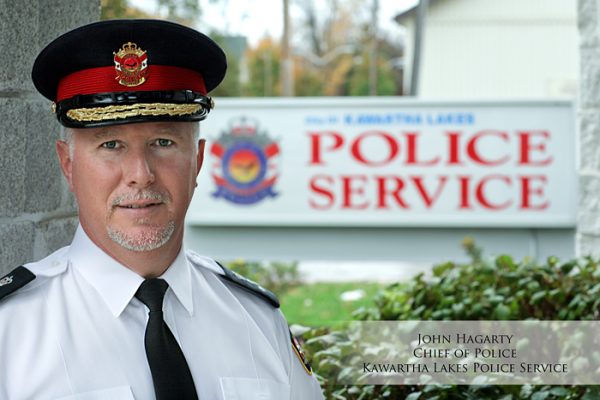Police Chief John Hagarty talks fentanyl, building community, and basic income

It’s the last year for John Hagarty as Lindsay’s chief of police, given his imminent retirement next fall, and it’s not shaping up to be an easy one.
The wave of fentanyl and other opioid-related deaths that has been surging across Canada has finally hit small-town Ontario – including Lindsay, Kawartha Lakes, and nearby Peterborough.
Hagarty knew it was coming to Kawartha Lakes. It was only a matter of time. Not only is there fentanyl to worry about, there is a far deadlier version known as carfentanil – a synthetic heroin laced with elephant tranquilizers, and 100 times more potent than regular fentanyl. Just a few granules are enough to be lethal, and they can easily be hidden within other drugs.
When asked if there are any similarities to the older crack cocaine crisis, the chief says it’s not the same at all.
“No, this is different. Crack cocaine was destroying lives, but it wasn’t causing overdoses and deaths.”
But the fentanyl issue does remind Hagarty of another drug challenge from a few years ago — methamphetamine, or crystal meth.
“I believe that the drug users are going to figure out that they are at a real risk of killing themselves, and stop using fentanyl-laced drugs,” Hagarty tells The Lindsay Advocate, “much as I believe they learned what methamphetamine was doing to them,” in the past.
Making Changes
When Hagarty arrived in Lindsay 12 years ago from the Stratford Police Service, there were three key areas he knew he wanted to address right away.
“We didn’t have a dedicated officer working on illegal drugs. We implemented that and almost immediately saw a reduction in drug related crimes like break and enters,” he says.
The Kawartha Lakes Police Service also had “dated and failing technology” and that was addressed.
The working environment Hagarty encountered could be summed up as “us versus them,” he says, and he and his team were able to make cultural changes to address this.
In fact, relationship building seems to be a key strength of the outgoing police chief. After arriving he made sure to facilitate a trusting and respectful relationship between the chief, police association and the police services board.
“That allowed us to work together collaboratively to solve problems without the need for grievances or arbitration,” says Hagarty.
In fact, in the 12 years Hagarty has served as chief there hasn’t been a single grievance or matter for arbitration. It’s not a philosophy he only considers for internal relationships, either.
“We have positive connections within every possible community organization and agency,” he says.
“We work in partnership with them collaboratively to try and solve problems. Sometimes we lead and sometimes we follow, but we always listen and adapt as we move forward,” says the chief.
Hagarty has seen a lot of changes in policing since he first became an officer.
He notes that public accountability has increased significantly, with more oversight bodies in place now, like the Special Investigations Unit and the Office of the Independent Police Review Director.
“Our equipment and use of force options and training have been enhanced,” too, says Hagarty.
“I started with a revolver, handcuffs and a 26 inch baton,” he points out.
Now, an officer is issued a pistol, handcuffs, expandable baton, OC spray (pepper spray) and a Taser, all of it with annual training.
Back when Hagarty started out as an officer, a typical Friday night would mean going “to domestics, bar fights, and arrest an impaired driver or two.”
“Now we still go to those and do that, but we are increasingly dealing with mental health issues, often making apprehensions, attending drug over doses,” all of which is significantly more time consuming than before.
Under Hagarty’s watch the position of ‘domestic violence coordinator’ was created, someone who reviews all of the domestic violence calls and ensures that they have been appropriately investigated and followed up on when necessary. This position also liaises with and works collaboratively with community partners, such as Women’s Resources.
Community Wellness
The police chief says he is a big believer in programs that help the overall community “because an unhealthy community…reduces individual development and increases their risk of victimization, resulting in crimes against them and others.”
“I believe that people need hope and an opportunity to succeed,” says Hagarty.
Without that sense of optimism, it can result in too many forms of escapism, including the abuse of legal and illegal substances, he says.
“This harms them, their families and most importantly their children who often get caught in a cycle of hopelessness,” the chief says.
That’s why Hagarty is a strong supporter of the basic income pilot in Lindsay.
“I think the basic income pilot is a step in the right direction to help some break that cycle.”
After he retires next fall, Hagarty says he will definitely be staying in the Lindsay area for at least another eight to 10 years. After that, he’s not sure what life will bring.
When asked if there was one defining moment during his career in Lindsay that he won’t forget, the chief says there are too many to isolate just one.
“Let’s just say that I came to work every shift, every day, in every capacity to help keep my community safe and to make a difference. And I got to do that, many many times.”








